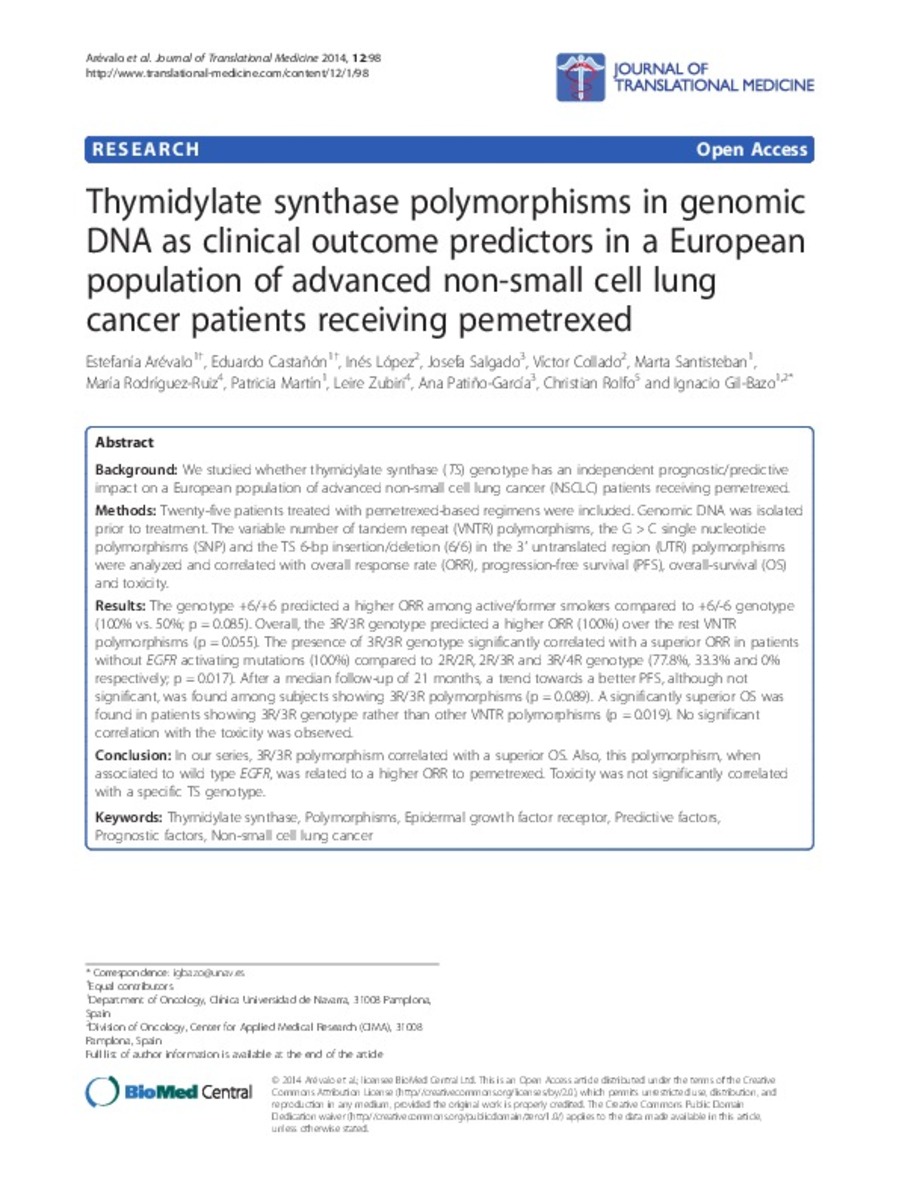Full metadata record
| DC Field | Value | Language |
|---|---|---|
| dc.creator | Arevalo, E. (Estefanía) | - |
| dc.creator | Castañon, E. (Eduardo) | - |
| dc.creator | Lopez, I. (Inés) | - |
| dc.creator | Salgado, J. (Josefa) | - |
| dc.creator | Collado, V. (Víctor) | - |
| dc.creator | Santisteban, M. (Marta) | - |
| dc.creator | Rodriguez-Ruiz, M.E. (María Esperanza) | - |
| dc.creator | Martin, P. (Patricia) | - |
| dc.creator | Zubiri, L. (Leire) | - |
| dc.creator | Patiño-García, A. (Ana) | - |
| dc.creator | Rolfo, C. (Christian) | - |
| dc.creator | Gil-Bazo, I. (Ignacio) | - |
| dc.date.accessioned | 2014-08-09T10:27:38Z | - |
| dc.date.available | 2014-08-09T10:27:38Z | - |
| dc.date.issued | 2014 | - |
| dc.identifier.citation | Arévalo E, Castañón E, López I, Salgado J, Collado V, Santisteban M, et al. Thymidylate synthase polymorphisms in genomic DNA as clinical outcome predictors in a European population of advanced non-small cell lung cancer patients receiving pemetrexed. J Transl Med. 2014 Apr 14;12:98 | es_ES |
| dc.identifier.issn | 1479-5876 | - |
| dc.identifier.uri | https://hdl.handle.net/10171/36252 | - |
| dc.description.abstract | BACKGROUND: We studied whether thymidylate synthase (TS) genotype has an independent prognostic/predictive impact on a European population of advanced non-small cell lung cancer (NSCLC) patients receiving pemetrexed. METHODS: Twenty-five patients treated with pemetrexed-based regimens were included. Genomic DNA was isolated prior to treatment. The variable number of tandem repeat (VNTR) polymorphisms, the G > C single nucleotide polymorphisms (SNP) and the TS 6-bp insertion/deletion (6/6) in the 3' untranslated region (UTR) polymorphisms were analyzed and correlated with overall response rate (ORR), progression-free survival (PFS), overall-survival (OS) and toxicity. RESULTS: The genotype +6/+6 predicted a higher ORR among active/former smokers compared to +6/-6 genotype (100% vs. 50%; p = 0.085). Overall, the 3R/3R genotype predicted a higher ORR (100%) over the rest VNTR polymorphisms (p = 0.055). The presence of 3R/3R genotype significantly correlated with a superior ORR in patients without EGFR activating mutations (100%) compared to 2R/2R, 2R/3R and 3R/4R genotype (77.8%, 33.3% and 0% respectively; p = 0.017). After a median follow-up of 21 months, a trend towards a better PFS, although not significant, was found among subjects showing 3R/3R polymorphisms (p = 0.089). A significantly superior OS was found in patients showing 3R/3R genotype rather than other VNTR polymorphisms (p = 0.019). No significant correlation with the toxicity was observed. CONCLUSION: In our series, 3R/3R polymorphism correlated with a superior OS. Also, this polymorphism, when associated to wild type EGFR, was related to a higher ORR to pemetrexed. Toxicity was not significantly correlated with a specific TS genotype. | es_ES |
| dc.language.iso | eng | es_ES |
| dc.publisher | BioMed Central | es_ES |
| dc.rights | info:eu-repo/semantics/openAccess | es_ES |
| dc.subject | Non-small cell lung cancer (NSCLC) | es_ES |
| dc.subject | European population | es_ES |
| dc.subject | Thymidylate synthase | es_ES |
| dc.subject | Genotype | es_ES |
| dc.title | Thymidylate synthase polymorphisms in genomic DNA as clinical outcome predictors in a European population of advanced non-small cell lung cancer patients receiving pemetrexed | es_ES |
| dc.type | info:eu-repo/semantics/article | es_ES |
| dc.identifier.doi | http://dx.doi.org/10.1186/1479-5876-12-98 | es_ES |
Files in This Item:
Statistics and impact
Items in Dadun are protected by copyright, with all rights reserved, unless otherwise indicated.






